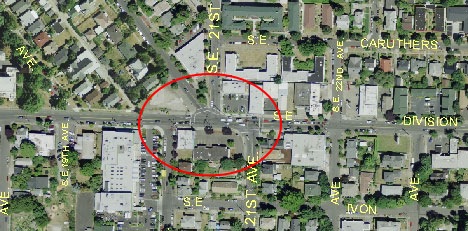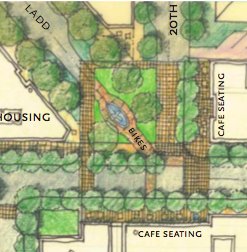
the creation of a new public plaza at
the end of Ladd Ave.
As I reported last month, the Office of Transportation and the Bureau of Planning have embarked on a project to improve the 7 Corners intersection (where SE Division, Ladd, 20th, and 21st streets converge).
At last night’s Bicycle Advisory Committee meeting, Tom Armstrong from the Bureau of Planning introduced the three design concepts and received feedback on how the designs might impact bike traffic.
Armstrong told us that the two goals of the project are “How can we enhance this area to give it a more distinctive place, while at the same time maintain mobility through the intersection.”
The most complicated aspect of this project is that SE Division is a four-lane, high-speed thoroughfare that gets about (according to Armstrong) 13-14,000 cars per day. That type of volume makes planners nervous and makes them worry about things like “congestion management implications” (more on that below).
Here are the three conceptual drawings for the intersection (descriptions from Bureau of Planning in italics, followed by my comments). Please keep in mind that these are just concepts meant to start discussion, no final designs have been approved:
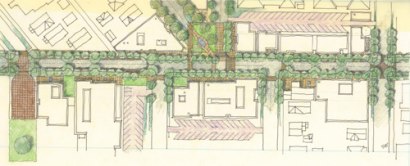
This alternative looks at restricting access for cars and buses at the end of Ladd Avenue and using the right-of-way to create a new public square at the heart of the 7 Corners intersection. (PDF, 220kb)
—
Armstrong said this option was popular at a recent open house. The idea is to create a public square in the right-of-way that would be open only to bikes and pedestrians. The signal (at Ladd and Division) would also be removed (to take that “green time” and re-allocate it to other streets to provide extra capacity/time in the signal phase).
There were several concerns raised about Alternative 1 by committee members. Of most concern is how bikes would navigate through the plaza to reach the signal at SE 20th. Armstrong admitted that it would be a “difficult movement” for southbound riders and said they’d probably put a bike box at 20th to help.
Committee member Mark Ginsberg expressed concern about what would happen during a green light, when you’ve got bikes coming across from Ladd onto SE 20th, while motor vehicles on SE 20th also have the green.
The Ladd Ave/SE 20th connection is a very busy corridor for bikes. Roger Geller said last night that recent bike counts at Ladd Circle (just north of this intersection) had the highest, non-bridge totals of anywhere in the city and counts at 21st and Clinton (south of the intersection) were also some of the highest in the city (550 bikes at a two-hour peak).
Geller said he’s “concerned” that the level of service for southbound bikes might be “diminished” with this alternative and he urged the committee to “keep a close eye on this project.”

This alternative shifts the focal point to the 21st Avenue intersection with urban plazas as an extension of the sidewalk. (PDF, 200kb)
—
This alternative would rely more on zoning changes that would (hopefully) spur private development along SE 21st and it would have the least amount of disruption to traffic flow.
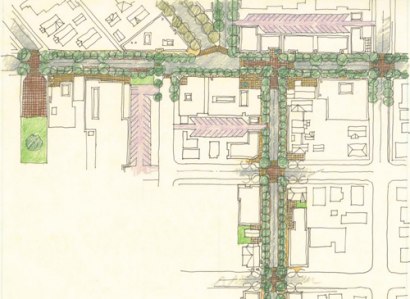
This alternative creates a new 2-block long pedestrian-friendly, commercial corridor that connects Division and Clinton. (PDF, 290kb)
—
This alternative brought up some concerns about the quality of biking on SE 21st, especially if it becomes more of a “commercial corridor”.
The big elephant in the room with this project is SE Division Street.
Division is a tough street to balance “livability and mobility” on, in part because it’s got what are known as “pro time” lanes. This means that during rush hour (when on-street parking is not allowed and all three lanes are filled with speeding cars) there’s absolutely zero shoulder space. This makes walking on the adjacent sidewalk unpleasant and according to the Bureau of Planning it, “requires the temporary removal of parking that can be critical to supporting small businesses.”
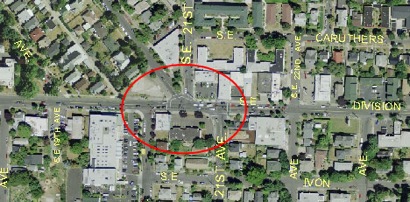
So, why not just scrap the “pro time” lanes and change Division to one motorized lane in each direction? Not so fast, says the Bureau of Planning’s website (emphasis mine):
“Removal of the pro-time lanes could increase congestion at the intersections, slow travel times for buses and cause back-ups. The increased congestion could, in turn, result in increased cut-through traffic on adjacent streets, such as Clinton Street, thereby increasing potential conflicts with bicyclists.”
They’ve painted a pretty dire picture of what a reduction of one lane (in each way) of motor vehicle capacity would do.
The website goes on to state that,
“The preferred strategy must balance livability enhancements with mobility and congestion management.”
That’s a tough order to fill. Is it possible to re-do a busy, high-speed intersection and achieve these goals?
I wonder if planners consider that if an area is made more pleasant and safe for non-motorized traffic, car trips and congestion will be reduced because people will choose other modes. (When I brought this up to Armstrong last night he said the majority of traffic on Division is local, meaning most likely many of the trips could be easily taken by bike).
I’m somewhat skeptical of the ability to truly balance all those needs, without sacrificing the livability component and the safe, efficient movement of bicycles. I’m reminded of the words of the former mayor of Bogota, Colombia, Enrique Penalosa (paraphrased); “You must decide. You can either build a city for cars or for people — but not for both.”
I wonder how we’re ever going to make non-motorized transportation a viable option if we are always afraid that we might “increase congestion”, “cause back-ups”, or “slow travel times”.
Several committee members last night echoed some of these sentiments. Instead of trying to fanagle bike traffic around motor vehicle traffic, why not use this project as an opportunity to make a statement that bikes have priority? Why not treat bikes as a mode on equal footing with cars?
A follow-up meeting where “a preferred strategy will be formulated for discussion” will be held on November 3rd with the re-design process to begin in earnest in late November.
If you have comments about this intersection and/or feedback on the design concepts, direct them to Tom Armstrong (click name for email).
